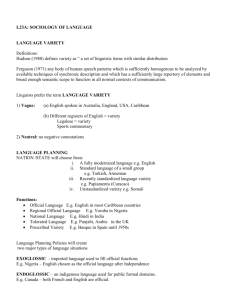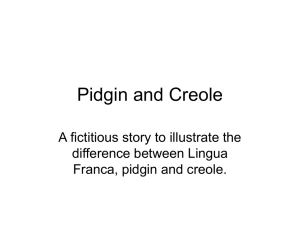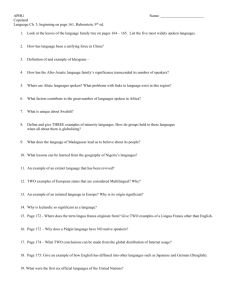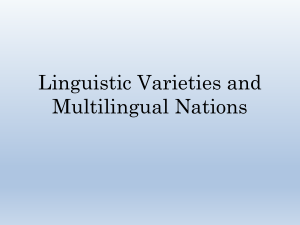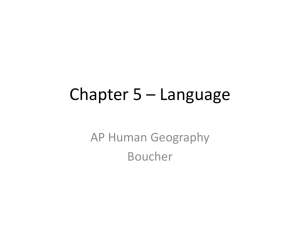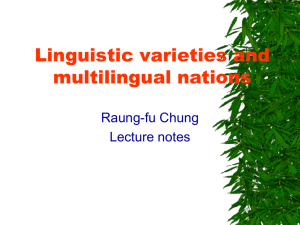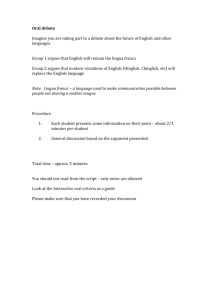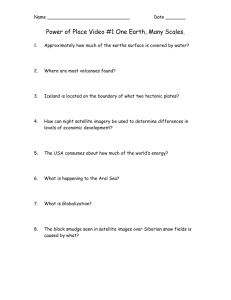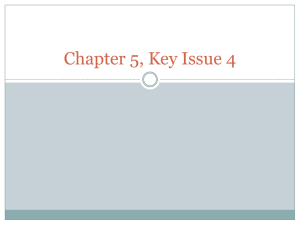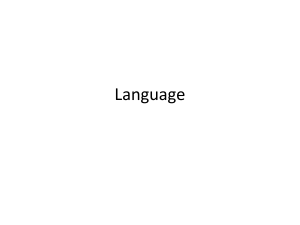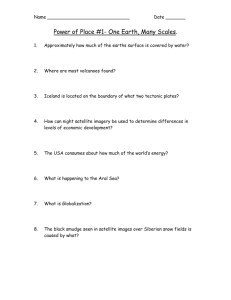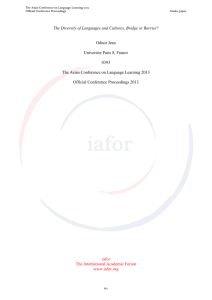Meeting IV Linguistic Varieties and Multilingual Nation
advertisement
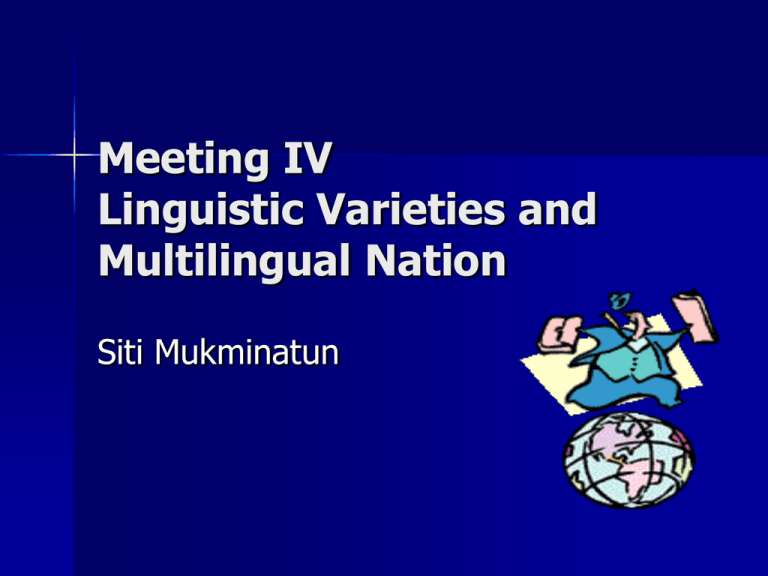
Meeting IV Linguistic Varieties and Multilingual Nation Siti Mukminatun Key terms Repertoire Vernacular Standard Lingua Franca Pidgin Creole Example I Kalala is 16 years old. He lives in Bukavu, an African city in eastern Zaire with a population of about 220,000. It is a multicultural, multilingual city with more people coming and going for work and business reasons than people who live there permanently. Over forty groups speaking different languages can be found in the city. Kalala, like many of his friends, is unemployed. He spends his days roaming the streets, stopping off periodically at regular meeting places in the market-place, in the park, or at a friend’s place. During a normal day he uses at least three different varieties or codes, and sometimes more. Example II Mr. Patel is a spice merchant who lives in Bombay. When he gets up he talks to his wife and children in Kathiawari, their dialect of Gujerati. Every morning he goes to the local market where he uses Marathi to buy his vegetables. At the railway station he buys his ticket into Bombay city using Hindustani, the working person’s lingua franca. He reads his Gujerati newspaper on the train, and when he gets to work he uses enough English to enjoy an English cricket commentary on the radio, but he would find an English film difficult to follow. However, since the spice business is flourishing, his children go to an English-medium school, so he expects them to be more proficient in English than he is. Vernacular language 1. 2. 3. refers to a language which has not been standardized and which does not have official status; refers to the way it is acquiredusually the first languages learned by people in multilingual communities; used for relatively narrow range of informal functions vernacular language 4. the most colloquial variety in a person’s linguistic repertoire 5. the variety used for communication in the home and with close friends 6. the language of solidarity between people from the same ethnic group An influential 1951 Unesco report Vernacular language • The first language of a group socially or politically dominated by a group with a different language e.g. ‘Spain’ in USA in which English dominates, but not in Spain itself (Spain as an official language) * A language which is not an official language in a particular context. The extension of vernacular language definitions 1. 2. in a monolingual community: the most informal and colloquial variety of a language which may also have a standardized variety A language used for everyday interaction, without implying that it is appropriate only in informal domains Standard languages 1. 2. more difficult to define rather than vernacular language used in many different ways by linguists one which is written, which has undergone some degree of regularizations or codifications (e.g. in a grammar and a dictionary) Standard languages 3. It is recognized as a prestigious variety or code by a community 4. It is used for H functions alongside the diversity of L varieties 5. Standard varieties are codified varieties. Standard languages Standard English emerged naturally in the 15th century from a variety of regional English dialects It was because this variety was used by the Court and the influential merchants of London. The area where the largest proportion of the English population lived in a neat triangle containing London: the Court was based and the two universities, Oxford and Cambridge, an important agricultural and business are, the hub of international trade and exports to Calais, the centre of political, social and intellectual life in England. Standard varieties are codified varieties. It has served as a useful variety for communication. Local varieties of English has developed in Malaysia, Singapore, India, and many African countries. The degree of variation has not been great. codification 1. 2. 3. achieved through grammars and dictionaries part of the development of every standard variety accelerated in the case of English by the introduction of printing by William Caxton, 1476 Three essential criteria of standard language 1. 2. 3. Influential or prestigious variety; Codified and stabilized; Served H functions (court, literature, administration Standard Language Standard language is a particular dialect which has gained its special position as a result of social, economic, and political influences. A standard dialect has no particular linguistic merits, whether in vocabulary, grammar, or pronunciation It is simply the dialect of those who are politically powerful and socially prestigious. Lingua Francas A language serving as a regular means of communication between different linguistic groups in a multilingual speech community A language used for communication between people whose first languages differ e.g. 1. academics and experts meet at international conferences or when politicians arrange summit meetings; English, French, or Spanish is often used as a lingua franca. 2. see example 3, p. 86-87 Holmes Example III In the 1960s, a Catholic nun, Sister Dominic, was sent to Rome for a meeting between nuns from different countries. She spoke no Italian but she had been managing pretty well with her French and English until she lost her purse on evening. She simply was not able to explain to the local police officer how she had lost her purse. A priest overheard her struggles and came to her rescue. They proceeded to explain their linguistic repertoires trying to find a language they shared. He came from Brazil and spoke Portuguese and Spanish, but he had been living in Rome for some time, and so he was by then familiar with the local variety of Italian. Finally, they found a language in which they could communicate- Latin. At that time Latin was still the language of church services and both learned Latin to university level. Lingua Francas In some countries the most useful and widely used lingua franca is an official language or the national language. e.g. 1. Swahili in Tanzania 2. Tok Pisin in Papua New Guinea 3. Russian among a hundred different vernaculars In multilingual communities, lingua franca may eventually displace the vernaculars. Often develop initially as trade languages e.g. ‘Hausa’ in west Africa, ‘Swahili’ in East Africathe becomes national language of Tanzania. Tok Pisin has a similar experience like Swahili. Lingua Franca UNESCO • A language used habitually by people whose mother tongue are different in order to facilitate communication between them. • A variety of other terms 1. a trade language (Hausa in west africa & Swahili –EA) 2. a contact language (Greek Koine in The ancient world) 3. an international language (English throughout the world) 4. an auxiliary language Pidgin A language which has no native speakers. develop as a means of communication between people who do not have a common language arise when two groups with different languages are communicating in a situation where there is also a third dominant language used almost exclusively for referential rather than affective functions used for specific functions like buying, selling, or animal hides, rather than to signal social distinctions or expressed politeness pidgin 1. 2. 3. 4. has no native speakers. As a means of communication between people who do not have a common language. Both contribute to the sounds, vocabulary, the grammatical features, and some additional features The prestigious language contribute much on vocabulary and the vernacular languages on the grammar of the developing pidgin Pidgin 5. simplified structure and a small vocabulary compared with fully develop languages 6. short life and disappear if the function disappears Three identifying characteristics of pidgin 1. 2. 3. It is used in restricted domains and functions It has a simplified structure compared to the source languages Low prestige and attracts negative attitudes-especially from outsiders Creole 1. 2. 3. A pidgin which has acquired native speakers They are learned by children as their first language and used in a wide range of domains. They become more structurally regular. Functions Pidgin can become lingua franca. Once a Creole has developed it can be used for all the functions of language, politics, education, administration. attitudes Outsiders’ attitudes to Creole are often as negative as their attitude to pidgin This is not always the case for those who speak them. Origin and endings found in every continent Most are based on one of seven European languages; English, French, Spanish, Portuguese, German, Dutch, and Italia The debate toward the origin of pidgin 1. 2. All pidgins and creoles have a common origin. Each pidgin arises and develops independently. They account for the similarities by pointing two types of constraints; 1. Pidgins arise in different contexts but for the same kinds of basic functions. 2. These functions are expressed through structural processes which seem universal to all situations of language development-such as simplification and reduction of redundant features The origin of Creole 1. 2. There are a variety of answers depending on the social context. In the societies with rigid divisions, a Creole remains as a stable L variety alongside an officially sanctioned H variety. Where the social barriers are more fluid, the Creole may develop towards the standard language (decreolisation) 3. used side by side with standard variety → standard variety → a continuum of varieties between the standard and creole 4. may be adopted as an official language e.g. Tok Pisin (PNG) Indonesian from Pidgin Malay
